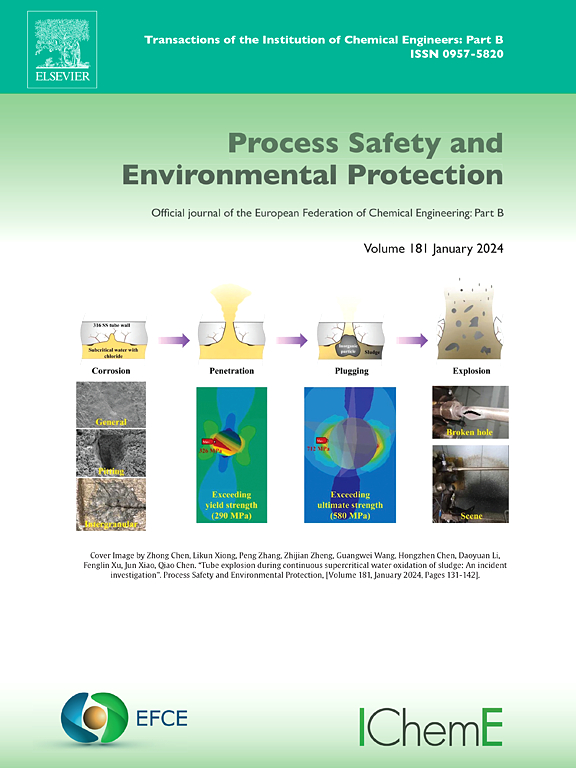Chlorine-related from two (2) incidents in water treatment plant: A comprehensive review on root cause analysis
IF 6.9
2区 环境科学与生态学
Q1 ENGINEERING, CHEMICAL
引用次数: 0
Abstract
Process industry accidents threaten people, the environment, and property, particularly when they use dangerous chemicals like chlorine. This study examines chlorine-related occurrences in water treatment facilities (WTPs), which frequently use chlorine gas for disinfection. Water treatment plants often maintain more than 20 drums of chlorine, with each drum bringing around 930 kg. This surplus amplifies intrinsic hazards owing to chlorine's reactivity and severe health repercussions upon exposure. Incidents such as the 2022 event in Bhopal, which resulted in the hospitalization of 15 individuals, and the 2017 occurrence in Kota Belud highlight the need for safe operational practices. This study investigates several chlorine-related incidents to determine common root causes and evaluate their consequences. The study examines root causes and preventive measures through the development of Fault Tree Analysis (FTA) and Event Tree Analysis (ETA). The research shows that effective ways to stop chlorine accidents, like working leak detectors, scrubber systems, and emergency shutdown valves (ESVs), are crucial. Should the ESVs malfunction, immediate intervention by a trained person, along with operational leak detectors and scrubber systems, can ensure the safety of the WTPs.
两起水处理厂氯相关事故:根本原因分析的综合回顾
加工工业事故威胁着人类、环境和财产,特别是当他们使用像氯这样的危险化学品时。本研究调查了经常使用氯气进行消毒的水处理设施(WTPs)中与氯有关的事件。水处理厂通常有20多桶氯,每桶大约有930 公斤。由于氯的反应性和接触后的严重健康影响,这种过剩放大了内在危害。2022年在博帕尔发生的事件导致15人住院,以及2017年在哥打贝卢德发生的事件突出了安全操作做法的必要性。本研究调查了几起与氯有关的事件,以确定常见的根本原因并评估其后果。该研究通过发展故障树分析(FTA)和事件树分析(ETA)来检查根本原因和预防措施。研究表明,有效阻止氯气事故的方法,如泄漏探测器、洗涤系统和紧急关闭阀(esv),是至关重要的。如果esv发生故障,训练有素的人员立即进行干预,并配合运行中的泄漏探测器和洗涤系统,可以确保wtp的安全。
本文章由计算机程序翻译,如有差异,请以英文原文为准。
求助全文
约1分钟内获得全文
求助全文
来源期刊

Process Safety and Environmental Protection
环境科学-工程:化工
CiteScore
11.40
自引率
15.40%
发文量
929
审稿时长
8.0 months
期刊介绍:
The Process Safety and Environmental Protection (PSEP) journal is a leading international publication that focuses on the publication of high-quality, original research papers in the field of engineering, specifically those related to the safety of industrial processes and environmental protection. The journal encourages submissions that present new developments in safety and environmental aspects, particularly those that show how research findings can be applied in process engineering design and practice.
PSEP is particularly interested in research that brings fresh perspectives to established engineering principles, identifies unsolved problems, or suggests directions for future research. The journal also values contributions that push the boundaries of traditional engineering and welcomes multidisciplinary papers.
PSEP's articles are abstracted and indexed by a range of databases and services, which helps to ensure that the journal's research is accessible and recognized in the academic and professional communities. These databases include ANTE, Chemical Abstracts, Chemical Hazards in Industry, Current Contents, Elsevier Engineering Information database, Pascal Francis, Web of Science, Scopus, Engineering Information Database EnCompass LIT (Elsevier), and INSPEC. This wide coverage facilitates the dissemination of the journal's content to a global audience interested in process safety and environmental engineering.
 求助内容:
求助内容: 应助结果提醒方式:
应助结果提醒方式:


